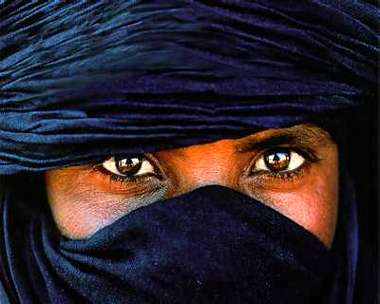
Blue People

Roy's fascination with maps began before he was eight years old. His curiosity about what people in distant lands looked like, what languages they spoke, and their customs, accelerated the more he read about countries whose names and geography he discovered in the Great World Atlas.In school one day, a substitute teacher named Arvid Scranton mentioned that just after the war he had been stationed in North Africa, and had traveled extensively in that region. In Morocco, he told Roy's class, he had been in a place called Goulimime, at the edge of the Sahara desert, where he had encountered the Blue People, a nomadic tribe called the Tuareg, who wore blue robes dyed with natural indigo that was absorbed by their skin and turned it blue. Many people believed, said Arvid Scranton, that the dye had become so pervasive over time that it entered the Tuaregs' bloodstream to the degree that their babies were born with a decidedly blue tinge to their otherwise black skin.
Roy was eleven when he learned of the existence of the Tuareg. A year later, he was playing in a basketball tournament at Our Fathers Out of Egypt, when he saw a blue person. The center on the team from Kings of Assyria had skin that was exactly as Arvid Scranton had described: deep, dark blue that glowed under and despite the dull yellow gymnasium lights. The kid on Kings of Assyria was taller than anyone else on either team and extremely thin, so thin that he was easily pushed around and brutalized by shorter but stockier opponents. Occasionally, he lofted a shot high over a defender's head that was impossible to block, but more often than not it clanged harmlessly off the rim of the basket, or banged too hard against the backboard. The kid had no touch, as well as not enough strength, and his team was easily defeated. After the game, Roy was tempted to ask him if he was related to the Tuareg of the Sahara, but he was afraid the kid would be offended, so he did not.
Later at Meschina's Restaurant, Roy and Jimmy Boyle were sitting at the counter eating club sandwiches and drinking Dad's root beers, when Roy told Jimmy about the Blue People, and how he figured the kid on Kings of Assyria must be related to them.
"You ever seen anyone else with skin dark blue like that?" Roy said.
Jimmy's mouth was too full to speak, so he just shook his head.
Lorraine, a waitress who had worked at Meschina's for forever, stopped in front of the boys and said, "My skin is black upon me, and my bones are burned with heat."
"'What's that?" asked Jimmy. "You aint black, and it's freezin' outside."
"Job, 30:30," said Lorraine. "I heard you talkin'. Kid must be descended from those desert people, the ones move around all the time."
"Nomads," said Roy.
"Roy says they turn blue because of the dye on their robes," said Jimmy.
"Very clever," Lorraine said. "I wish I could just wear a red babushka over my hair to make it stay red, then I wouldn't have to pay the beauty parlor no more."
As Roy and Jimmy walked home from Meschina's, the sky got dark fast and snow began to fall. A hard wind made them duck their heads.
"The weather in Chicago'll turn you blue, too," said Jimmy, "You get stuck out in it too long."
"Good thing that blue kid couldn't shoot," Roy said.
"He could," said Jimmy, "nobody'd stop him."
"He's too skinny," said Roy, "but if he keeps playin', he'll learn how to score and beef up as he ges older. Probably be a pro, he grows more."
"Good thing for him his family moved here," said Jimmy. "I bet they don't play basketball much in the Sahara desert."
--- From The Roy Stories
Barry Gifford
©2013, Seven Stories Press